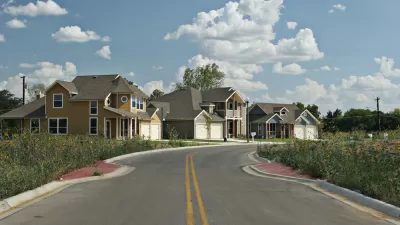Location, location, location. Choosing a smart home location can help households become healthy, wealthy and wise, since it affects residents’ physical activity levels, long-term financial burdens and opportunities for education and social interaction.
Location, location, location. Choosing a smart home location can help households become healthy, wealthy and wise, since it affects residents' physical activity levels, long-term financial burdens and opportunities for education and social interaction.
Several recent studies advocate smart growth development to help achieve various planning objectives, including affordability, health, energy conservation and pollution emission reductions. Just last week the Transportation Research Board released a major new report, Driving and the Built Environment: The Effects of Compact Development on Motorized Travel, Energy Use, and CO2 Emissions which concludes that cost effective smart growth policies can make a substantial contribution toward climate change emission targets.
These proposals are not without critics. Their main argument against smart growth is that, by reducing the supply of large-lot, urban fringe housing, smart growth harms consumers and contradicts market demand. For example, Alan Pisarski writes in a recent blog, "It is clear that most people, excepting a small but often very loud minority, opt for lower density living when income permits." Smart growth criticism rests primarily on this claim. Is it true?
I investigate this question in my new report, Where We Want To Be: Home Location Preferences And Their Implications For Smart Growth. It evaluates consumer housing preferences. Here is what I found.
Although market surveys indicate that most North American households preferred single-family homes, they also indicate strong preferences for smart growth features such as improved accessibility (shorter commutes), land use mix (nearby shops and services), and diverse transport options (good walking conditions and public transit services) and will choose small-lot and attached homes that offer these features.
The current housing market demonstrates a major shift in consumer preferences toward smart growth. Demand for sprawl housing is declining, resulting in oversupply and reduced value. Urban fringe housing is readily available for sale and rent at discounted prices. The current stock of large-lot housing should be adequate for decades, but the supply of small-lot and attached housing will need to approximately double by 2025 to meet consumer demands.
These shift result from various demographic and economic trends, including aging population, rising fuel prices, more positive attitudes about urban living, and increased health and environmental concerns. In addition, suburban living and suburban housing investments have lost their glamour. The housing market correction in 2008 spoiled this confidence. Households are likely to be more cautious and rational in the future. Described differently, for a few decades, consumer decisions seemed to defy the rules of economics. Households chose dispersed housing locations with little consideration to the resulting increase in transport costs. Increased congestion, rising fuel prices, health and environmental concerns are forcing consumers to be more rational. Some embrace this opportunity but others react with fear.
This is not to suggest that automobile travel and suburban living will end. Even with aggressive smart growth policies most North Americans would continue to live in single-family houses, although a greater portion of those will be small-lot and attached housing, such as townhouses.
Rather than harming consumers, smart growth benefits consumers directly and indirectly. Many sprawl location households would probably be better off had smart growth policies been implemented years ago. They would now be less vulnerable to stresses such as higher fuel prices, job loss or illness, and would enjoy other benefits such as time savings, reduced accident rates, and increased physical fitness and health.
Smart growth critics are wrong to claim that sprawled development and automobile-dependent lifestyles are normal and socially desirable. Those reflect unique circumstances that occurred between 1950 and 1980: growing vehicle ownership, Baby Boom generation family formation, low fuel prices, increased female employment, middle-class flight from cities, highway expansion, and the excitement and prestige that resulted from rapid technological development. Virtually all of those factors have peaked. Driving will probably never be as cheap or as exciting as it was during that period.
When smart growth critics claim that sprawl is a universal preference they probably reflect their own preferences and those of similar-aged friends and neighbors. Most younger people I know prefer more urban neighborhoods, enjoy physically active transport, and telecommunications improvements (mobile telephone or Internet access) more than new vehicle technologies.
For more information see:
Reid Ewing, Keith Bartholomew, Steve Winkelman, Jerry Walters and Don Chen (2007), Growing Cooler: The Evidence on Urban Development and Climate Change, Urban Land Institute and Smart Growth America (www.smartgrowthamerica.org/gcindex.html).
Reid Ewing (2007), "The Demand For Smart Growth: What Survey Research Tell Us," Planning, American Planning Association; at www.smartgrowth.umd.edu/pdf/Research_Dec07.pdf.
Christopher B. Leinberger (2008), "The Next Slum," Atlantic Monthly, March 2008; at www.theatlantic.com/doc/200803/subprime.
Jonathan Levine (2006), Zoned Out: Regulation, Markets and Choices in Transportation and Metropolitan Land Use, Resources for the Future (www.rff.org).
Todd Litman (2004), Evaluating Criticism of Smart Growth, VTPI (www.vtpi.org); at www.vtpi.org/sgcritics.pdf.
Todd Litman (2006), Understanding Smart Growth Savings, VTPI (www.vtpi.org); at www.vtpi.org/sg_save.pdf.
Todd Litman (2009), Where We Want To Be: Home Location Preferences And Their Implications For Smart Growth, Victoria Transport Policy Institute (www.vtpi.org); at www.vtpi.org/sgcp.pdf.
Arthur Chris Nelson (2006), "Leadership in a New Era," Journal of the American Planning Association, Vol. 72, No. 4 (www.planning.org); at http://law.du.edu/images/uploads/rmlui/conferencematerials/2007/Thursday/DrNelsonLunchPresentation/NelsonJAPA2006.pdf.
John V. Thomas (2009), Residential Construction Trends in America's Metropolitan Regions, Development, Community, and Environment Division, U.S. Environmental Protection Agency (www.epa.gov); at www.epa.gov/smartgrowth/pdf/metro_res_const_trends_09.pdf.
TRB (2009), Driving and the Built Environment: The Effects of Compact Development on Motorized Travel, Energy Use, and CO2 Emissions, Special Report 298, Transportation Research Board (www.trb.org); at http://onlinepubs.trb.org/Onlinepubs/sr/sr298prepub.pdf.
ULI (2009), Emerging Trends in Real Estate, Urban Land Institute (www.uli.org); at www.uli.org/ResearchAndPublications/EmergingTrends/Americas.aspx.
Eric Weiss (2008), "Gas Prices Apply Brakes To Suburban Migration," Washington Post, 5 August 2008; www.washingtonpost.com/wp-dyn/content/article/2008/08/04/AR2008080402415.html.

Planetizen Federal Action Tracker
A weekly monitor of how Trump’s orders and actions are impacting planners and planning in America.

Restaurant Patios Were a Pandemic Win — Why Were They so Hard to Keep?
Social distancing requirements and changes in travel patterns prompted cities to pilot new uses for street and sidewalk space. Then it got complicated.

Map: Where Senate Republicans Want to Sell Your Public Lands
For public land advocates, the Senate Republicans’ proposal to sell millions of acres of public land in the West is “the biggest fight of their careers.”

Maui's Vacation Rental Debate Turns Ugly
Verbal attacks, misinformation campaigns and fistfights plague a high-stakes debate to convert thousands of vacation rentals into long-term housing.

San Francisco Suspends Traffic Calming Amidst Record Deaths
Citing “a challenging fiscal landscape,” the city will cease the program on the heels of 42 traffic deaths, including 24 pedestrians.

California Homeless Arrests, Citations Spike After Ruling
An investigation reveals that anti-homeless actions increased up to 500% after Grants Pass v. Johnson — even in cities claiming no policy change.
Urban Design for Planners 1: Software Tools
This six-course series explores essential urban design concepts using open source software and equips planners with the tools they need to participate fully in the urban design process.
Planning for Universal Design
Learn the tools for implementing Universal Design in planning regulations.
Heyer Gruel & Associates PA
JM Goldson LLC
Custer County Colorado
City of Camden Redevelopment Agency
City of Astoria
Transportation Research & Education Center (TREC) at Portland State University
Camden Redevelopment Agency
City of Claremont
Municipality of Princeton (NJ)




























